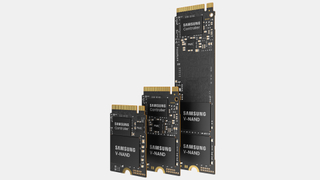Being the world's largest supplier of 3D NAND both in terms of revenue and bit shipments, Samsung regularly adopts leading-edge production nodes to increase the bit density and capacities of its solid-state drives. At the China Flash Memory Market Summit, the company said that capacity of a single SSD can increase to 1 petabyte (PB, or 1,024 terabytes), but this is obviously not going to happen overnight.
According to a report from A&SMag, Samsung expects 3D NAND to continue both physical and logical scaling, meaning that NAND flash cell sizes will decrease and the number of layers will increase, so that each layer will be able to store more data. Furthermore, Samsung anticipates more advanced packaging technologies for 3D NAND ICs. Physical, logical, and packaging innovations will increase the capacity of a drive to 1PB within the next decade, the company indicated at the event.
Samsung has been supplying some of the industry's highest-capacity SSDs for a long time. The company was among the first to mass produce a 15.36TB drive in 2016, then it rolled out a 3D TLC-based 30.72TB product in 2017. These drives aren't on our list of the best SSDs due to mediocre performance (not to mention extremely high prices, from a consumer standpoint), but those who need loads of flash storage can take advantage of these spacious drives. Samsung also demonstrated a 64TB SSD in 2019 and then showcased a 3D QLC NAND-based 128TB prototype SSD in 2021, but those devices have yet to enter mass production.
In fact, unlike some of its industry peers, Samsung uses 3D QLC NAND memory rather conservatively and is currently "researching ways to bring QLC technology into the mainstream" by innovating its controllers.
But Samsung seems to admit that physical scaling (shrinking NAND cells and increasing the number of NAND layers) to ~1000-layers per 3D NAND device is not enough by itself to rapidly increase the bit density of flash memory, and so, logical scaling (increasing the number of bits stored per cell) is needed.
Unlike Samsung, Kioxia (formerly Toshiba) has been particularly vocal about logical scaling of NAND. Back in 2019, Kioxia was the first 3D NAND manufacturer to discuss the development of PLC (penta level cell) 3D NAND memory capable of storing 5 bits per cell (bpc). Kioxia's team of scientists and engineers followed up with a demonstration of operational 3D HLC (hexa level cell) 3D NAND memory that stored 6 bpc in 2021. The company even expressed the opinion that 8bpc OLC (octa-level cell) 3D NAND memory was possible.
To store six bits per cell, this NAND cell must hold 64 voltage levels, whereas an 8bpc OLC 3D NAND needs to hold 256 voltage states. Increasing the number of bits per cell presents multiple challenges for manufacturers.
Firstly, they must identify the right materials that can store 64 or 256-voltage states while also being able to differentiate between them to ensure they do not interfere with each other. Secondly, they need to be able to produce using such material in high volume. Thirdly, they have to manage temperatures for such 3D NAND, yet it becomes increasingly difficult as the number of bits per cell increases. Finally, they have to develop extremely complex ECC algorithms for 3D HLC and 3D OLC NAND memory and such controllers will require significant compute horsepower. As a result, the cost of such controllers may offset the benefits of logical scaling of 3D NAND.
Samsung will face many of these challenges on the path to enabling 1 petabyte SSDs within the next decade, but for now the company isn't sharing further details of how it hopes to accomplish the feat.

